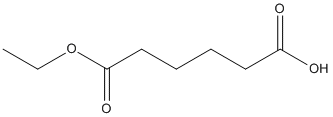Monoethyl-adipate
General
Type : Fatty acid ester
Chemical_Nomenclature : 6-ethoxy-6-oxohexanoic acid
Canonical SMILES : CCOC(=O)CCCCC(=O)O || CCOC(=O)CCCCC(=O)[O-]
InChI : InChI=1S\/C8H14O4\/c1-2-12-8(11)6-4-3-5-7(9)10\/h2-6H2,1H3,(H,9,10) || InChI=1S\/C8H14O4\/c1-2-12-8(11)6-4-3-5-7(9)10\/h2-6H2,1H3,(H,9,10)\/p-1
InChIKey : UZNLHJCCGYKCIL-UHFFFAOYSA-N || UZNLHJCCGYKCIL-UHFFFAOYSA-M
Other name(s) : Adipic acid monoethyl ester, AAME, 6-Ethoxy-6-oxohexanoic acid, Monoethyl adipate, Ethyl hydrogen adipate, Hexanedioic acid, monoethyl ester, AC1ODTY3, ACMC-209n6z, MolPort-028-748-220

Target
Families : Polyesterase-lipase-cutinase, Cutinase
References (4)
| Title : Cutinase ACut2 from Blastobotrysraffinosifermentans for the Selective Desymmetrization of the Symmetric Diester Diethyl Adipate to the Monoester Monoethyl Adipate - Rauter_2022_Microorganisms_10_1316 |
| Author(s) : Rauter M , Nietz D , Kunze G |
| Ref : Microorganisms , 10 : , 2022 |
| Abstract : Rauter_2022_Microorganisms_10_1316 |
| ESTHER : Rauter_2022_Microorganisms_10_1316 |
| PubMedSearch : Rauter_2022_Microorganisms_10_1316 |
| PubMedID: 35889035 |
| Gene_locus related to this paper: blaad-a0a060t5x1 , blaad-a0a060t512 , blaad-a0a060t6b2 |
| Title : Structural Dynamics of the PET-Degrading Cutinase-like Enzyme from Saccharomonospora viridis AHK190 in Substrate-Bound States Elucidates the Ca(2+)-Driven Catalytic Cycle - Numoto_2018_Biochemistry_57_5289 |
| Author(s) : Numoto N , Kamiya N , Bekker GJ , Yamagami Y , Inaba S , Ishii K , Uchiyama S , Kawai F , Ito N , Oda M |
| Ref : Biochemistry , 57 :5289 , 2018 |
| Abstract : Numoto_2018_Biochemistry_57_5289 |
| ESTHER : Numoto_2018_Biochemistry_57_5289 |
| PubMedSearch : Numoto_2018_Biochemistry_57_5289 |
| PubMedID: 30110540 |
| Gene_locus related to this paper: sacvd-c7mve8 |
| Title : Three New Cutinases from the Yeast Arxula adeninivorans That Are Suitable for Biotechnological Applications - Bischoff_2015_Appl.Environ.Microbiol_81_5497 |
| Author(s) : Bischoff F , Litwinska K , Cordes A , Baronian K , Bode R , Schauer F , Kunze G |
| Ref : Applied Environmental Microbiology , 81 :5497 , 2015 |
| Abstract : Bischoff_2015_Appl.Environ.Microbiol_81_5497 |
| ESTHER : Bischoff_2015_Appl.Environ.Microbiol_81_5497 |
| PubMedSearch : Bischoff_2015_Appl.Environ.Microbiol_81_5497 |
| PubMedID: 26048925 |
| Gene_locus related to this paper: blaad-a0a060t5x1 , blaad-a0a060t512 , blaad-a0a060t6b2 |
| Title : Control of the phytopathogen Botrytis cinerea using adipic acid monoethyl ester - Vicedo_2006_Arch.Microbiol_184_316 |
| Author(s) : Vicedo B , de la OLM , Flors V , Finiti I , Del Amo G , Walters D , Real MD , Garcia-Agustin P , Gonzalez-Bosch C |
| Ref : Arch Microbiol , 184 :316 , 2006 |
| Abstract : Vicedo_2006_Arch.Microbiol_184_316 |
| ESTHER : Vicedo_2006_Arch.Microbiol_184_316 |
| PubMedSearch : Vicedo_2006_Arch.Microbiol_184_316 |
| PubMedID: 16261314 |